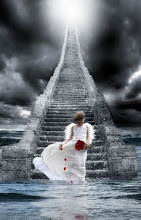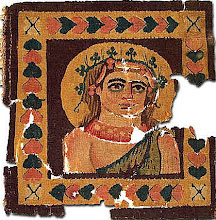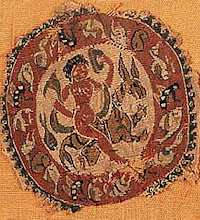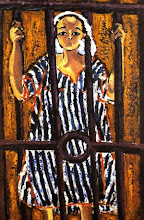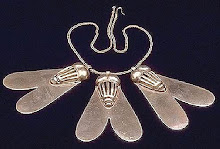Yesterday was a very full day - the highlight was visiting the artist, Francisco Brennand on his 4000 acre estate near Recife. Francisco is the descendant of 19th century Irish immigrants to Brazil. His father ran a brick and tile works and Francisco inherited it. For the last 40 years, he has been working in clay and is about 85 years old. Before that, he painted and still paints in as he says "a more traditional and less controversial style." His clay sculptures, some of which are absolutely monumental, decorate the grounds of his estate as well as the interior of the converted tile factory and gigantic kilns. The buildings are absolutely beautiful. his cousin, Ricardo Brennand also has a sizeable estate but has chosen to house his 5000+ collection of swords in a medieval styled castle. He also has, in his collection, armor and paintings. We weren't able to see Ricardo's collection but had the opportunity to actually talk with the artist since one of the former ambassadors of Brazil accompanied us and is a personal friend.
I asked Francisco where the clay came from and what kind of glazes he used. He said that the clay was specially chosen from a place in Pernambuco because of its properties and the glazes were not scientifically applied or mixed but were rather the result of such a long experience with them. I took lots and lots of pictures of the sculptures, tile wall collages and the temple. Outdoors, he has a sacred site with a blue egg shaped dome that colors everything with a celestial blue hue when the sun is directly overhead.
I have to disagree with Lonely Planet's description of this famous artist and site. They describe his work as weirdly sexualized earthworms, lizards and frogs. Did they actually see his work? Yes, some of the pieces might appear phallic at first glance and yes, sensuality and sexuality is a part of Francisco's style but he makes frequent references to creation, mythology, history and biblical references with a twist. Adam and Eve are represented outside as is Cain but Cain is given complete redemption in Francisco's interpretation as he should be. He is the one who gave the gifts of the earth and the harvest rather than shedding the blood of animal in sacrifice to God. Frogs and fish emerge from the waters of the pools and fountains, large ceramic eggs stand on end ready to hatch into what the viewer chooses to imagine. Inside, Joan of Arc has two heads symbolizing perhaps her two natures or the way that she was both virgin and dressed as a man to get the job done of crowning the Dauphine King of France.
One can feel a mysticism and animism and spiritual force walking around Brennand's clay bodies and forms. He said that none of them can be moved or separated from each other. Another quotation that I found very inspiring was "My art may be immovable but it is not inert." In fact, nothing on earth is inert, not even rocks, rivers or sand. Everything is alive. Before leaving all too soon, I was able to buy a small sphere from the restaurant gift area made by Brennand that I will keep in my office in our new Art building so that I can be reminded of the Brazilian artist with the kindly face who is one of Brazil's most important living artists. If you go to Brazil you must visit both cousins. They are exceedingly kindly men, our tour guide, Ni tells us - she is a native Pernambuca native Brazilian - who do a lot for the poor in the municipality.
The talk about urban planning in the state was not as inspiring, I'm afraid. It focused on development of the Boa Viagem beachfront area and moving the poor out of their shanty towns along the waterfront where they eke out a living by fishing. The solution, unfortunately for low income housing is to move people out to the fringes of the city where it is nearly impossible to get to any kind of work situation. In some areas that we passed through in Recife like San Antonio and San Jose, there has been frequent flooding so that some houses that used to be for the wealthy were abandoned. Gabe and I have decided that we could start a business here with a power washing company to get rid of the mold that seems to constantly endanger the health of Recife's inhabitants. We would add a little bleach to it and then sell at low cost, dehumidifiers too. Gabe is my fellow Hawaiian from Hilo - he has taught at the community college there for over nine years so he's become an official Hawaiian native in my classification.
That was Monday July 11. Now today, July 12, we had an appointment to visit the new Port of SUAPE nearly one and a half hours away. It takes such a long time because first of all, the roads are terrible with potholes like you can't believe. And then there is the traffic. Anyway, we were presented with a 9 minute slick video about the publicly owned port of Suape (which we were given as well along with the power point on CD) which is giving private companies huge tax incentives to ship things in and out of Brazil. The tax break is around 75% so it will definitely benefit those private companies. There is a shipyard, fiberglass company, resin company and lots of others. They say they are dedicated to sustainability and maintaining a large green area around the port. They have two Goliath cranes that can lift 1500 tons which is important in shipbuilding. Suape has very deep water at its port and is the closest to Africa of any site in Brazil. Their plans are expansive and will give jobs to many Brazilians in this state. Well, more jobs as they are building the port and other buildings and less when the building is complete. Of the total number the private companies are supposed to employ 50% Brazilians - I imagine for the lower paying jobs.
I asked about waste management and air quality control for pollutants. I was told that containment areas were designated and when I asked where? I didn't feel that I was answered in detail but we were given the email account of the VP who spoke with us and he promises to find answers and then get back to us. Hopefully there will be no DuPont situations or oil spills. They have very close offshore oil sites and oil refineries are being built by Petrobras, the largest oil company in Brazil on the site as well. I took some photos from a site where our bus drove us so that we could see an over view. Pernambuco is one of Brazil's poorer states.
Is Brazil a country of the future? Will Brazil be able to reap the benefits the capitalism without selling its soul and the health of its people? Many other questions will come up I'm sure as I think about the ramifications of conservation, sustainability, social welfare, etc.
Wednesday, July 13, 2011
Subscribe to:
Comments (Atom)








